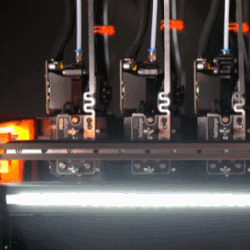

Ask Hackaday: Are Extruders The Only Feasible Tools For Toolchanging?
source link: https://hackaday.com/2021/12/13/ask-hackaday-are-extruders-the-only-feasible-tools-for-toolchanging/
Go to the source link to view the article. You can view the picture content, updated content and better typesetting reading experience. If the link is broken, please click the button below to view the snapshot at that time.

Ask Hackaday: Are Extruders The Only Feasible Tools For Toolchanging?
Toolchanging in 3D printers is no longer something from the bleeding edge; it’s going mainstream. E3D has a high-quality kit for a toolchanger and motion system, our own Joshua Vasquez has shared details about the open-source toolchanging Jubilee design, and just recently Prusa3D formally announced the Prusa XL, which promises toolchanging with up to five different extruders.
 A toolchange in progress
A toolchange in progress
It’s safe to say toolchanging on 3D printers has stepped to the front, but what comes next? What kind of tools other than extruders make sense on a 3D printer?
First, let’s explain what makes separate extruders such fantastic tools. Being able to change extruders on-demand during a print enables things like true multi-material printing. Printing in more than one color or material will no longer be done by pushing different filaments through a single nozzle, which limits a print to materials that extrude under similar conditions and temperatures. Toolchanging means truly being able to print in multiple materials, even if they have different requirements, because each material has its own extruder. That’s a clear benefit, but what about tools other than extruders?
3D Printers Have Often Been Modded To Do More
Cutting tools and lasers are two common 3D printer retrofits that seem to be likely candidates for toolchanging, but they are not without their own issues. Lasers require eye protection and ventilation, and cutting tools create troublesome dust and fragments. Nevertheless, over the years we’ve seen quite a few 3D printers modified into light-duty laser cutters, or converted to CNC engravers. It doesn’t end there; we’ve seen an extruder that embeds copper wire into prints, and even printers turned into through-hole soldering machines.
As clever as these are, some are really just repurposing a 3D printer into something else, and the results have little or nothing to do with the business of extruding plastic to create objects. But others do seem aimed at genuinely enhancing the 3D printing process by adding new capabilities, and could make worthwhile candidates for tools in a toolchanging 3D printer. But which ones make practical sense?
The Best Tools Might Be Ones We Haven’t Seen Yet
The most useful tools are likely to be ones that help a 3D printer do its work better, or more efficiently. For example, E3D have made a pretty solid case that a cutting tool as a secondary processing step can add real value to 3D prints under the right conditions.
Another example of enhancing prints is ironing, which uses an extruder’s nozzle to smooth out the surface of prints. It looks fantastic when it works, but as that link explains, reliability and results can vary. Perhaps a specialized tool, designed specifically for ironing, could smooth prints more reliably and efficiently than an extruder nozzle? Such a tool might even be useful for embossing prints, as well.
A more ambitious task would be a pick-and-place tool that can drop hardware like nuts or magnets into a print while it’s in progress. 3D prints that contain captive hardware would no longer need a human operator involved; a boon for using 3D printers in a manufacturing role.
Of course, the possibilities aren’t limitless. A tool will be limited to a certain size and shape, and a 3D printer’s frame and construction will also play a part in what is feasible. For example, a cutting tool requires the machine to press the tool into the part being cut, but no such force is required to move an extruder when 3D printing. A machine’s capabilities may limit what is possible to do with a given tool. But the enthusiasm with which hackers have pursued things so far makes me suspect that there’s much more where all that came from.
Do Tools Besides Extruders Make Sense?
Maybe robust and open toolchanging won’t just be bringing multi-material printing to workbenches. Perhaps its real contribution will be the way it continues to enable the kind of enthusiastic experimentation hackers have displayed for modifying 3D printers, and lead to things we haven’t even seen yet. In the meantime, extruders seem to be enough to worry about.
What’s your experience with toolchanging? Are things like pens, lasers, and cutters on a 3D printer just gimmicks, or can they actually enhance and improve the job of creating useful plastic parts? We’re listening, so let us know what you think in the comments.
Recommend
About Joyk
Aggregate valuable and interesting links.
Joyk means Joy of geeK